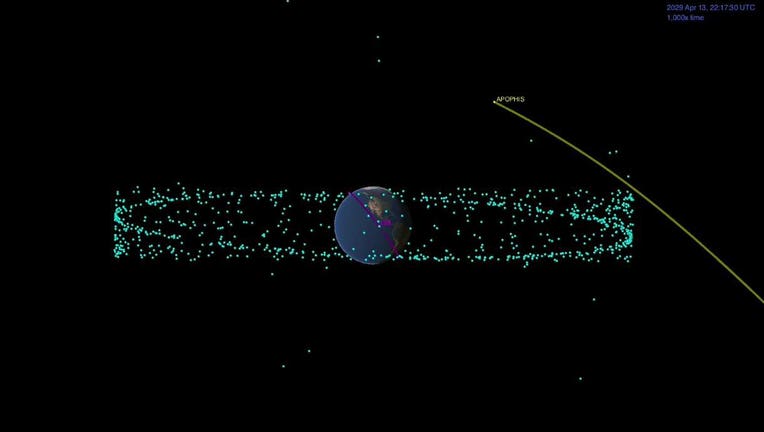NASA's spacecraft will rendezvous with rare asteroid coming close to Earth

Asteroid Apophis Image Credit: NASA/JPL-Caltech
On its way back to Earth with a hefty sample of asteroid Bennu, the team behind NASA's OSIRIS-REx mission has big plans for the space rock-chasing spacecraft.
After the spacecraft drops off the sample next year, it will begin a new mission to study near-Earth asteroid Apophis, earning a new acronym OSIRIS-APEX.
NASA recently approved $200 million to cover the extended mission, which was welcome news to the University of Arizona-led team.
With a new mission, a new scientist will be in charge.
University of Arizona planetary science professor Daniella DellaGiustina will become the principal investigator under the APEX mission, but she is not new to the spacecraft. She currently serves as deputy principal investigator on the OSIRIS-REx mission and has been part of the program since she was an undergraduate student in 2005 before NASA selected it.
Instead of traveling through the solar system and collecting a sample as the spacecraft did in 2020, this time, OSIRIS-APEX gets to wait for its subject a little closer to home. Asteroid Apophis is set to make a close flyby of Earth in 2029, close enough that we can see it with the naked eye.
"It's a really captivating object because, at one point in the early 2000s, there was a big scare after it was discovered that it might impact the Earth in 2029 during this encounter," DellaGiustina said. "It gets within a 10th of the distance between the Earth and the moon, and something like that only happens about once every 7,500 years."
However, there is no reason for concern. Apophis is not going to hit Earth.
Captured on Oct. 20 during the OSIRIS-REx mission’s Touch-And-Go (TAG) sample collection event, this series of 2 images shows the SamCam imager’s field of view at the moment before and after the NASA spacecraft touched down on asteroid Bennu’s surface. The sampling event brought the spacecraft all the way down to sample site Nightingale, and the team on Earth received confirmation of successful touchdown at 6:08 pm EDT. (Credit: NASA/Goddard/University of Arizona)
Captured on Oct. 20 during the OSIRIS-REx mission’s Touch-And-Go (TAG) sample collection event, this series of 2 images shows the SamCam imager’s field of view at the moment before and after the NASA spacecraft touched down on asteroid Bennu’s surface. (Credit: NASA/Goddard/University of Arizona)
DellaGiustina explained the team learned during the Bennu sample collection that the spacecraft thrusters moved rocks and dirt around, helping them know about the asteroid's surface properties. They will do that on purpose with Apophis instead of a sample collection.
"We're going to point the spacecraft thrusters at the surface and sort of blow and displace material around … and we'll survey the asteroid and look at just how much material did we end up displacing," she said. "That's going to give us a great idea of how strong the surfaces and also what does it look like sort of beneath the surface, which is really important for understanding how we might mitigate one of these objects in the future if it was on a collision course with our own planet."
OSIRIS-REx holds the Guinness Book of World Records for the smallest object ever orbited. Apophis is estimated to be smaller than Bennu and will offer up a new set of challenges.
The length of a day on Bennu was about 4.5 hours as it rotates on its axis. A day on Apophis is long, but DellaGiustina said her team believes that will change as it gets closer to either.
Imaging scientists Dathon Golish created this simulated image of the view of near-Earth asteroid Apophis in the APEX camera, based on a shape model produced by JPL's Marina Brozović and her colleagues.(credit: UArizona/JPL/Arecibo)
Imaging scientists Dathon Golish created this simulated image of the view of near-Earth asteroid Apophis in the APEX camera, based on a shape model produced by JPL's Marina Brozović and her colleagues.(credit: UArizona/JPL/Arecibo)
CLICK HERE TO GET THE FOX WEATHER UPDATE PODCAST
"We're going into this situation knowing that we're going to have to do a little bit of rework on the fly," she said. "This is both the orbit of Apophis, and its rotation rate probably are altered when it gets so close to the earth. And so there will be a little more thinking on our feet, so to speak, than was the case at Bennu."
In September 2023, OSIRIS-REx will drop the Bennu sample off to Earth and then the spacecraft will perform a maneuver to avoid getting pulled into Earth's atmosphere. At that point, the mission team will go on two different paths: one stays with the sample, beginning to analyze it, and DellaGiustina's team will be focused on the cruise period to Apophis.
While OSIRIS-APEX waits for its new asteroid to arrive, it will take pictures of the moon and Earth to re-calibrate its instruments. Then in late March 2029, Apophis will begin to come into view. The team will get to work trying to understand the asteroid's rotation rate and the length of the day on Apophis.
Then after a year of surveying the asteroid up close, in October 2030, OSIRIS-APEX will conduct a regolith excavation by spacecraft thrusters (REST) maneuver. Which is a fancy way of saying, "we blow a bunch of material around on the surface and then take a second look to see what exactly we did," according to DellaGiustina.
OSIRIS-APEX is one of a series of NASA-funded missions designed to study asteroids. In August, an Arizona State University-led mission will launch from Florida to study a metallic asteroid called Psyche.

